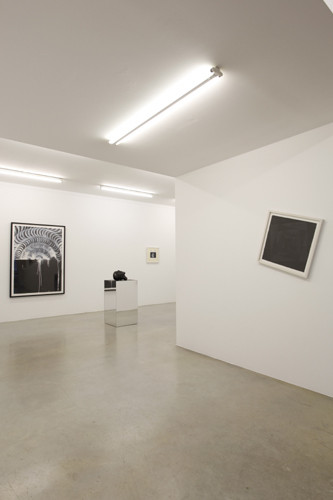Julian Hoeber
17 Jan - 07 Mar 2009
JULIAN HOEBER
Praz-Delavallade is pleased to announce the first solo exhibition of works by Julian Hoeber in France.
This body of works picks up on the formal strategies the artist has been running lately -- black and white opticaldrawings in series ; bronze sculptures of human heads which have been violently altered--as well as a few of his oldermodes such as trompe l'oeil and collage. The very change in this show is the addition of some more harmonious formsthat tend towards pure abstraction.
" My practice has been one that has involved a lot of difficult subject matter--violence, sex, love, political apathy, andmental illness. There is still certainly an ongoing fascination with nausea and alienation which I've tried to approach inthis new show through form, optics and space. Two central ideas are inaction, or the sense of being trapped, and theidea of the void. Images of guns that cannot be fired, abstractions that resemble outer space, images of prisoners andcrass jokes on psychological cliches about toilet habits.
These new works feature the addition of colorful abstract collages on the backside of the drawings. I had changed the technique for making the optical drawings to a method of painting the entire paper black and drawing the white areas byremoving them with a knife.
To keep the works from literally falling apart I had to glue a paper backing on the drawing to strengthen them. As Istarted doing this I saw that the backs of the drawings were another surface to make an image on. It reminded me ofdrawing as a child, flipping the paper over and using the other side because one just wants to keep going. The finaldestination of the work is unimportant when you're a kid. It just matters that you're making things. I also thought abouthow one often sees drawings from the Renaissance with images on both sides of the paper because paper was soexpensive at this time.
As I started to work I thought I could think of the backs as a sort of secret, a place where I could make drawings I mightnot usually show. It's funny that for me the secret work, the work that I'd almost be ashamed to show, is one that isharmonious and pretty. Once I had completed a few of them I felt like the beauty on the back side of the drawings madea sort of good joke. I've always told people that behind all of the aggressive and confrontational stuff in my work was apersonal sense of harmony and generosity. It seemed to me that the colorful abstractions on the backs of the worksliteralized this statement. Now the confrontational optical drawings actually had something beautiful behind them. It alsobegan to feel to me that this somewhat hidden aspect of the drawings functioned like a subconscious mind for theworks."
Praz-Delavallade is pleased to announce the first solo exhibition of works by Julian Hoeber in France.
This body of works picks up on the formal strategies the artist has been running lately -- black and white opticaldrawings in series ; bronze sculptures of human heads which have been violently altered--as well as a few of his oldermodes such as trompe l'oeil and collage. The very change in this show is the addition of some more harmonious formsthat tend towards pure abstraction.
" My practice has been one that has involved a lot of difficult subject matter--violence, sex, love, political apathy, andmental illness. There is still certainly an ongoing fascination with nausea and alienation which I've tried to approach inthis new show through form, optics and space. Two central ideas are inaction, or the sense of being trapped, and theidea of the void. Images of guns that cannot be fired, abstractions that resemble outer space, images of prisoners andcrass jokes on psychological cliches about toilet habits.
These new works feature the addition of colorful abstract collages on the backside of the drawings. I had changed the technique for making the optical drawings to a method of painting the entire paper black and drawing the white areas byremoving them with a knife.
To keep the works from literally falling apart I had to glue a paper backing on the drawing to strengthen them. As Istarted doing this I saw that the backs of the drawings were another surface to make an image on. It reminded me ofdrawing as a child, flipping the paper over and using the other side because one just wants to keep going. The finaldestination of the work is unimportant when you're a kid. It just matters that you're making things. I also thought abouthow one often sees drawings from the Renaissance with images on both sides of the paper because paper was soexpensive at this time.
As I started to work I thought I could think of the backs as a sort of secret, a place where I could make drawings I mightnot usually show. It's funny that for me the secret work, the work that I'd almost be ashamed to show, is one that isharmonious and pretty. Once I had completed a few of them I felt like the beauty on the back side of the drawings madea sort of good joke. I've always told people that behind all of the aggressive and confrontational stuff in my work was apersonal sense of harmony and generosity. It seemed to me that the colorful abstractions on the backs of the worksliteralized this statement. Now the confrontational optical drawings actually had something beautiful behind them. It alsobegan to feel to me that this somewhat hidden aspect of the drawings functioned like a subconscious mind for theworks."

